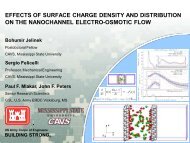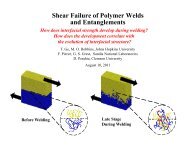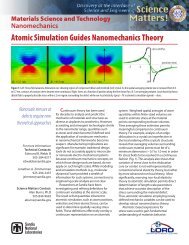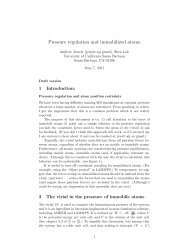1.1 Uniaxial compression in Copper (SCRIPT1): - Lammps
1.1 Uniaxial compression in Copper (SCRIPT1): - Lammps
1.1 Uniaxial compression in Copper (SCRIPT1): - Lammps
Create successful ePaper yourself
Turn your PDF publications into a flip-book with our unique Google optimized e-Paper software.
Figure 1.3: <strong>Uniaxial</strong> Quasi-isentropic <strong>compression</strong> along (100) <strong>in</strong> <strong>Copper</strong> (500,000 atoms). The image<br />
show the profiles of pressure, temperature, stra<strong>in</strong>-rate and volume obta<strong>in</strong>ed after runn<strong>in</strong>g the modified<br />
HACK version of LAMMPS<br />
1.3 Shock Compression <strong>in</strong> Niquel (SCRIPT3):<br />
Consider a cont<strong>in</strong>uous block of material of constant cross-section A. A piston drives <strong>in</strong>to the material<br />
with a velocity U p . In the situation be<strong>in</strong>g considered here, the piston is travell<strong>in</strong>g at a constant velocity.<br />
Therefore the material beh<strong>in</strong>d the shock is travell<strong>in</strong>g at the same velocity as the piston. From figure 1.4<br />
and 1.5 it can be seen that the motion of the piston causes an <strong>in</strong>crease <strong>in</strong> the density of the material<br />
ahead of it, as the material is ’gathered up’. The action of the piston, which causes the material to beg<strong>in</strong><br />
mov<strong>in</strong>g, and the resultant <strong>in</strong>crease <strong>in</strong> density causes a shock to travel forward at velocity U s .<br />
Figure 1.4: Schematic of shock propagation<br />
VERSION 1.0 12 CONTACT: gumo_99 at hotmail.com
















